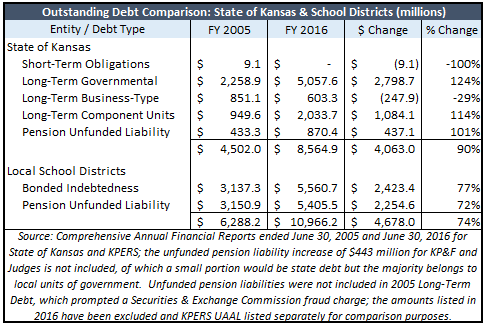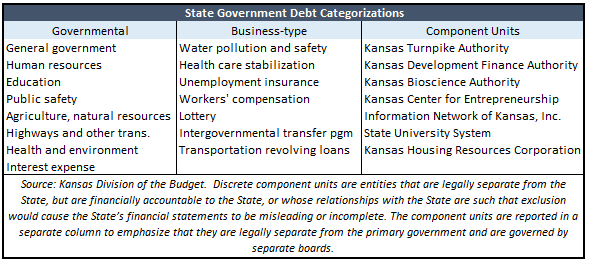Given media and legislative hyperventilation over state debt levels, one would never know that Kansas’ 286 school districts are deeper in hock than the State of Kansas and its component units (universities, turnpike authority, etc.). School districts set a new record last year of $5.56 billion in bonded indebtedness and they also have $5.4 billion in unfunded pension liability, putting total debt just shy of $11 billion. The State of Kansas and its component units collectively owe about $8.6 billion, of which only $870 million is unfunded pension liability. The accuracy of the following table has been confirmed by the Kansas Division of the Budget.
 Contrary to popular belief, Governmental Accounting Standards Board (GASB) statements 67 and 68 specify that unfunded school pension liabilities are the obligation of individual school districts rather than the State. The State of Kansas provides funding for the annual payments but because it is not contractually obligated to do so, GASB says the liability rests with the employer – in this case, school districts.
Contrary to popular belief, Governmental Accounting Standards Board (GASB) statements 67 and 68 specify that unfunded school pension liabilities are the obligation of individual school districts rather than the State. The State of Kansas provides funding for the annual payments but because it is not contractually obligated to do so, GASB says the liability rests with the employer – in this case, school districts.
Actual pension liabilities are even higher than reflected in the KPERS annual reports because the unfunded liability calculation presumes plan assets will earn 8 percent annually, and most pension experts believe that assumption to be several percentage points above reality. The latest KPERS annual report says dropping the assumed return by just one point would increase the unfunded liability across all plans by $2.95 billion. Proportionally, that would increase the State and School pension liabilities by $301 million and $1.9 billion, respectively; the balance would go to plans for Local government, Judges and Police & Fire. Funding pensions at a more realistic return on investments of say, 6 percent, would increased State debt by $602 million and school debt would increase by $3.8 billion.
FYI, the school unfunded liability is so much greater than that of state employees because the school plan is only 59 percent funded and has many more participants than the state plan, which is 77 percent funded. While 59 percent funded is considered seriously at risk, the school plan was only 17 percent funded when schools turned over management of the plan to the State.
Definitions and Documentation
FY 2005 State Comprehensive Annual Financial Report





